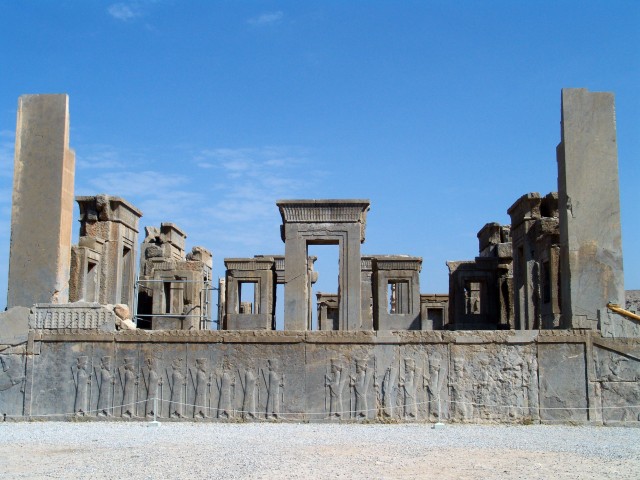Persepolis
ONE OF THE MOST magnificent cities of the ancient world, Persepolis was the political, cultural, and religious center of the Achaemenian PERSIAN EMPIRE for over 200 years before its complete destruction at the hands of Alexander the Great in 330 B.C.E.
The ruins of Persepolis lie at the foot of Kuh-i-Rahmat, the “Mountain of Mercy,” in the plain of Marv Dasht about 400 mi (650 km) south of the present capital of IRAN, TEHRAN. The site is remote, in a large barren plain surrounded by sharp cliffs, and the ruined city lay hidden for over a thousand years before it was identified in 1620. It was occasionally visited by the curious, but it was not until the 1930s that a scientifically planned expedition was sent to excavate and systematically map and catalog the ruins.
The Persepolis Expedition was sponsored by the University of Chicago's Oriental Institute, later joined by the University Museum in Philadelphia and the Boston Museum of Fine Arts. Its leaders were Ernst Herzfeld and Erich Schmidt, and the project employed up to 500 men recruited from local villages: diggers, draftsmen, recorders, mechanics, and others. World War II put an end to this project, which was taken up again after the war by the Iranian Antiquity Service and the Italian Institute of the Middle and Far East in Rome.

Persepolis was founded sometime in the reign of Darius I, probably around 518 or 516 B.C.E. Inscriptions show that he imagined the city to be a magnificent showpiece for the mighty new empire he and his predecessors, Cyrus and Cambyses, had created. It was called Parsa, City of the Parsis (“Persepolis” in Greek); it is known today in Iranian as Takht-e-Jamshid, “the Throne of Jamshid,” a mythical king of Persia. The Achaemenid kings made it an administrative center as well as a stage for receptions and ceremonial festivities. Wealth from all corners of the empire was featured in its decoration to showcase the immensity and diversity of the empire. Darius did not live long enough to finish his project. In fact, most of Persepolis was built by his son, Xerxes. Still, the complex was not entirely completed until the reign of Artaxerxes I, about 100 years later.
The main feature of the city was the palace complex, a large terrace, about 990 by 1,485 ft (300 by 450 m), rising 33 to 66 ft (10 to 20 m) above the surrounding ground. On this terrace were built the main ceremonial buildings: the Apadana, the Throne Hall, the Gate of Xerxes, the palaces of Darius and Xerxes, the Harem, the Treasury, and the Council Hall. The Audience Hall of the Apadana is the largest and most splendid of these buildings, with 72 columns (of which 13 still stand), two monumental stairways, and rows of reliefs with representations of the 23 subject nations of the empire—each bearing tribute gifts—followed by Persian and Median court notables, soldiers, horses, and royal chariots. A short distance from the city, other grandiose buildings were built to house the tombs of the Achaemenid kings, similar to the Valley of the Kings in EGYPT.
Persepolis was renowned for its beauty and splendor, but because it was such a strong symbol of Persian power and glory, it was an obvious target for Alexander the Great. Alexander's destruction of the city was thus highly symbolic of his complete victory over the Persians. According to Plutarch, Alexander's men burned the entire complex to the ground and carried away its treasures on 20,000 mules and 5,000 camels.